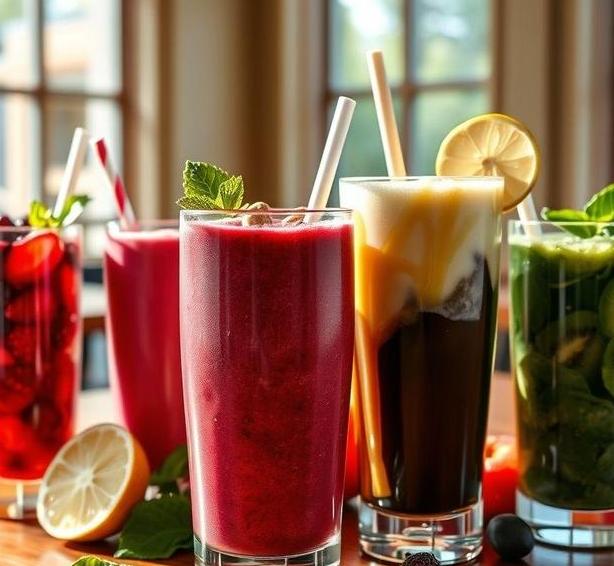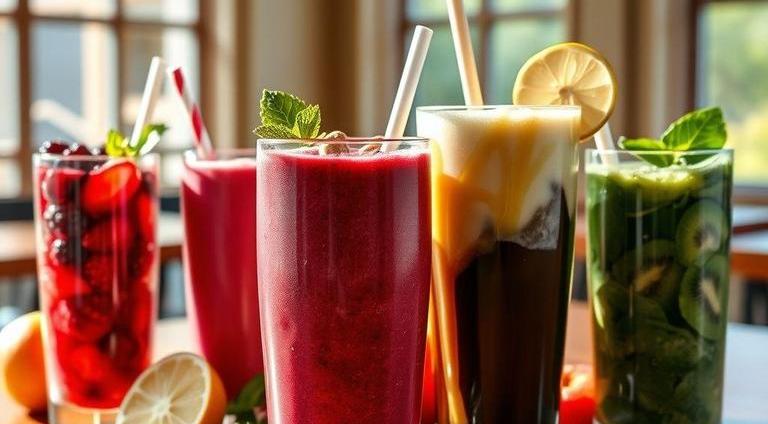Smoothies, with their vibrant colors and refreshing flavors, have become a popular choice for a quick, healthy meal or snack. Whether it’s a morning energy booster, a post-workout recovery drink, or a midday pick-me-up, smoothies offer a convenient way to pack in nutrients from fruits, vegetables, and other wholesome ingredients. But while we love whipping up these delightful blends, there’s often a lingering question: Can smoothies go bad?
You might find yourself wondering if that smoothie you made yesterday or bought from the store is still safe to drink. Like any food or beverage, smoothies have a shelf life, and if you don’t consume them quickly enough or store them improperly, they can turn bad. In this guide, we’ll delve into the details of how long smoothies last, how to spot spoilage, and the best practices for storage. Let’s make sure you’re always sipping on something fresh and safe!
Can Smoothies Go Bad?
Absolutely. Just like any food or drink, smoothies can spoil. The natural ingredients, especially fresh fruits and vegetables, have a limited shelf life due to their high moisture content and the presence of enzymes. Even if you toss your smoothie in the fridge, it won’t stay fresh indefinitely. Spoiled smoothies can have an off taste, texture, or even an unpleasant smell, which are all key signs that it’s time to toss them out.
Some factors that influence how quickly smoothies can go bad include:
- Type of Ingredients: Fresh fruits and veggies tend to spoil faster than frozen ones.
- Added Dairy or Non-Dairy Milks: Ingredients like milk, yogurt, and plant-based milks are perishable and can spoil quickly once blended.
- Sweeteners & Add-ins: Things like honey, agave syrup, and protein powders don’t spoil as quickly but may still affect the overall shelf life.
- Storage Method: How and where you store your smoothie matters a lot when it comes to maintaining its freshness.
Shelf Life For Smoothie

Knowing how long your smoothie will last is crucial so that you don’t waste any ingredients and can enjoy it at its best quality. The shelf life of a smoothie depends on various factors, such as whether it’s homemade or store-bought, the ingredients used, and how it’s stored.
-
Homemade Smoothies
- In the Fridge: Typically, a homemade smoothie can last 1 to 2 days in the fridge. This is because fresh ingredients like fruits and vegetables start to degrade quickly once blended. The texture may also change as the smoothie separates.
- In the Freezer: If you freeze your smoothie, it can last for up to 3 months. Freezing helps preserve the flavor and nutrients, but make sure to store it in an airtight container or freezer bag to prevent freezer burn.
-
Store-Bought Smoothies
- Unopened: These can last anywhere from 1 week to several months depending on preservatives and packaging. Always check the expiration date on the packaging.
- Opened: Once you open a store-bought smoothie, it should generally be consumed within 1 to 3 days, depending on the ingredients and storage conditions. After opening, the shelf life dramatically decreases due to exposure to air.
The key takeaway here is that freshness is everything when it comes to smoothies. While freezing can extend their life, the best taste and nutrient quality are found when they’re consumed fresh.
Common Signs Of Spoilage
So how do you know if your smoothie has gone bad? There are a few telltale signs that should make you think twice before sipping that last bit:
- Off Smell: The most noticeable sign that your smoothie has gone bad is a sour or off-putting odor. Fresh fruit smoothies should smell sweet and fruity, while a spoiled smoothie may have a fermented, unpleasant smell. Dairy-based smoothies may have a sour, rancid smell.
- Separation and Texture Change: It’s normal for smoothies to separate over time, but if the texture has become chunky or slimy, or if it has an odd, curdled appearance, that’s a red flag. This usually happens because the fruits and other liquid ingredients break down, making the smoothie too thick or separating.
- Color Change: A smoothie that’s turned brown or gray (especially one that was originally bright and vibrant) may have oxidized, and while this doesn’t always mean it’s unsafe, it could signal that its freshness has passed.
- Tastes Off: Of course, if your smoothie tastes sour, bitter, or ’off’ in any way, it’s time to toss it. Trust your taste buds-if it doesn’t taste right, don’t drink it.
- Mold: This might be obvious, but any visible mold on the surface is a sure sign that your smoothie has gone bad. Mold can appear in as little as 1-2 days depending on the ingredients, especially if it’s left in a warm place.
How To Store Smoothies?

Proper storage can significantly extend the shelf life of your smoothie, especially if you don’t plan to drink it right away. Whether you make your own smoothies at home or buy pre-made ones, here’s how to store them for maximum freshness:
-
In The Fridge
- Store your smoothie in an airtight container to prevent air from getting in and causing oxidation. Glass jars with tight-fitting lids or BPA-free plastic containers work well.
- If you’re making a smoothie to drink later, give it a shake or stir when you’re ready to consume it, as smoothies can separate over time.
-
In The Freezer
- If you make large batches of smoothies, consider freezing them for future use. Use freezer-safe glass containers or freezer bags to avoid freezer burn.
- You can even freeze individual servings in ice cube trays. Once frozen, transfer the cubes to a larger container. This makes it super easy to grab and blend with other ingredients later.
- Freeze ingredients ahead of time: Another great idea is to freeze your smoothie ingredients individually (fruits, greens, yogurt, etc.) in a bag. Then, when you want a smoothie, simply blend it straight from the freezer.
-
Store-Bought Smoothies
- Always keep them in the fridge, and don’t leave them out at room temperature for extended periods of time.
- Follow the manufacturer’s instructions on the packaging, as some smoothies are designed to last longer than others due to preservatives or pasteurization.
Expert Tips
To get the most out of your smoothies, here are some expert tips for both storage and making the freshest blends possible:
- Avoid Over-Blending: Over-blending can break down the nutrients in fruits and veggies more than necessary, especially when they’re stored for a few days. Blend just enough to get a smooth consistency, and if you’re storing it, try to blend again before drinking.
- Use Freezer-Friendly Containers: If you plan to store smoothies in the freezer, make sure your containers are designed for freezing. This ensures that your smoothies don’t develop freezer burn, which can make them taste bland or strange once thawed.
- Keep Ingredients Balanced: When prepping smoothies for later storage, try to balance wet ingredients (like milk or yogurt) with dry ingredients (like protein powder or flaxseeds) to reduce separation. You can also try adding a thickener like chia seeds, which help stabilize the consistency.
- Don’t Add Ice Before Freezing: If you want to freeze your smoothie, don’t add ice before freezing. Ice can water down the smoothie when it’s thawed, affecting both the texture and taste. If you need to add ice for your fresh smoothie, add it right before blending.
FAQs
Can Smoothies Go Bad If Left At Room Temperature?
Yes, smoothies can go bad if left at room temperature for extended periods. Perishable ingredients like fruits, dairy, or plant-based milks can spoil, leading to bacterial growth and a sour taste. It’s recommended to refrigerate smoothies within two hours of preparation.
How Long Can Smoothies Last In The Refrigerator?
Smoothies can last up to 24-48 hours in the refrigerator, depending on the ingredients. However, they are best consumed within 24 hours for optimal flavor and freshness. After this period, the taste and texture may degrade, and the smoothie could separate.
Can Smoothies Go Bad In The Freezer?
Smoothies can be stored in the freezer for 1-3 months without going bad. Freezing helps preserve the nutrients and freshness, but the texture may change slightly once thawed. It’s important to store smoothies in an airtight container to prevent freezer burn.
How Can You Tell If A Smoothie Has Gone Bad?
If a smoothie has gone bad, you may notice changes in its smell, taste, or texture. It might develop a sour odor, an off taste, or separation of liquids and solids that can’t be mixed back together. If there is mold growth or unusual discoloration, it’s also a sign the smoothie should be discarded.
What Causes A Smoothie To Go Bad?
A smoothie goes bad primarily due to the growth of bacteria or mold from ingredients like fruits, dairy, or leafy greens. Exposure to heat, improper storage, or contamination during preparation can accelerate spoilage. Ingredients like protein powder or nut butter may also spoil faster under improper conditions.
Can You Drink A Smoothie After The Expiration Date?
It’s not recommended to drink a smoothie after its expiration date, especially if it contains dairy or other perishable ingredients. The smoothie may spoil before the expiration date, and drinking it could lead to foodborne illness. Always check the freshness and smell before consuming.
Can Smoothies Be Made Ahead Of Time And Stored?
Yes, smoothies can be made ahead of time and stored in the refrigerator for up to 24 hours. If you want to store them for longer periods, freezing the smoothie is a better option. It’s advisable to store smoothies in airtight containers to retain their quality.
Do Smoothies With Dairy Go Bad Faster Than Non-dairy Smoothies?
Yes, smoothies with dairy products like milk or yogurt tend to spoil faster than those made with non-dairy alternatives, such as almond milk or coconut milk. Dairy products are more prone to bacterial growth, especially if left at room temperature.
Can Smoothies With Protein Powder Go Bad?
Yes, smoothies with protein powder can go bad. Protein powder itself may not spoil quickly, but the other ingredients in the smoothie (such as milk, fruits, or vegetables) can deteriorate, leading to the smoothie going bad. Protein powder should also be stored in a cool, dry place to prevent moisture from causing clumping or spoilage.
Is It Safe To Drink A Smoothie If It Separates In The Fridge?
It’s generally safe to drink a smoothie that has separated in the fridge, as long as it doesn’t show signs of spoilage, such as an off smell, sour taste, or mold. Simply stir the smoothie to recombine the ingredients, and check the freshness before consuming.